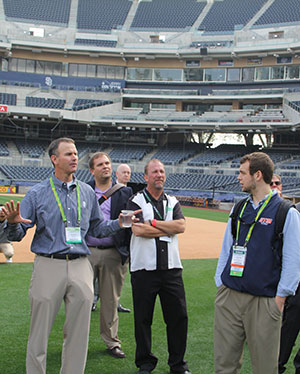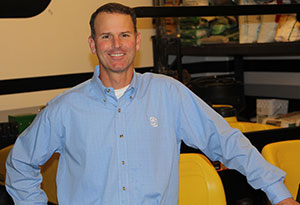A Decade a Padre
Luke Yoder, director of field operations for the San Diego Padres, looks back at how he got to where he is, and the unique challenges Petco Park provides.
It doesn’t feel like 10 years since Luke Yoder arrived at Petco Park, home of Major League Baseball’s San Diego Padres. But the calendar doesn’t lie — it was June of 2003 when Yoder left the Pittsburgh Pirates’ home field of PNC Park to take on the construction of Petco’s field.

Luke Yoder, director of field operations for the San Diego Padres, talks turf with stadium visitors.
“It flew by. I feel blessed,” Yoder says. “Time flies when you’re having fun.”
Yoder, a native of South Carolina, got his start in the business as many do — as a neighborhood lawn boy. His dad forced him into the job, and before he knew it, the business became quite profitable. But he didn’t think there was a future in it. “I didn’t even know you could major in horticulture when I was in high school,” Yoder recalls.
If his dad first got him into the business, his uncle was the one who showed him the finer side of it. Mark Yoder was the golf course superintendent at Scioto Country Club in Columbus, Ohio, for some 30 years before recently retiring. Mark Yoder is one of the more well known superintendents in Ohio, having mentored many superintendents in the area.
“I’d never seen turf like that before, it was like carpet,” Yoder recalls. “He said, ‘You should major in horticulture.’ He got his B.S. at Ohio State University. He made me aware that this was out there. I went from taking care of home lawns to seeing that… I knew this is what I wanted to do.”
After earning a B.S. in horticulture and turfgrass management from Clemson University, Yoder thought he would be working on a golf course. An advisor convinced him to work at a ballpark before he committed to golf. Yoder gave it a try with the Greenville Braves, which was then the Double-A affiliate of the Atlanta Braves.
“When I graduated, I said I’ll try baseball, and if it doesn’t pan out I’ll go back to golf,” Yoder says. After a few “slap-in-the-face” offers from minor league teams, Yoder got a last-minute offer from the Sioux City Explorers.
“It was enough to make a halfway decent living right out of college,” Yoder says. It was also a case of the right place at the right time. After one year, he got an offer from the Triple-A Iowa Cubs in Des Moines. “Suddenly I had skipped some levels — I was in Triple-A, just below the big leagues. I thought this might pan out.”
Pan out it did. Yoder spent four years with the Cubs, where he was named groundskeeper of the year for the American Association. That honor got him interviews with both the Detroit Tigers and the Pittsburgh Pirates. He got the Pirates job and was in Pittsburgh to build the field at PNC Park. Yoder remained for three years before moving west to take the San Diego job.
Unique challenges
The San Diego job entails more than one ballpark for Yoder. His responsibilities include all of the Padres’ minor league affiliates, though it’s rare he has to do any work on any of those fields, as they all have their own crews doing a great job.
The Padres’ Dominican Summer League ball fields, however, is a different story.
“I’ve made a dozen trips to the Dominican Republic over the last 5, 6 years. I go down there to help them dial it up and show them how to use the equipment,” Yoder says. “In the past they were lucky to have a weed wacker or a rotary mower. They used to edge the whole field with a machete and a string. Now they’ve got a real edger and a triplex mower. That’s been a really rewarding experience, to help those guys come along.”
Things back home in San Diego keep him plenty busy as well. Recent construction projects include moving the outfield fences in, and moving the visitor bullpen off the field.
Some people assume that Yoder’s job is an easy one, since the weather in San Diego is typically so nice. But there are two main challenges facing the crew at Petco Park: transitioning to bermudagrass and toxic water that can burn the infield edges.
“Here, a hot day in the summer is 80, so it’s tougher to transition (from ryegrass to bermudagrass.) It doesn’t get hot enough to push bermuda until late June. Getting to ryegrass is easy. From July to September, the ryegrass becomes shallow rooted. That bermuda base is very important to us,” Yoder says. “Every time the team goes out of town we’re doing something; verticutting, topdressing, pulling cores, trying to push the bermuda. We’ve got to be careful though, if we don’t have the bermuda base there, we’re in trouble.”
And the toxic water?
“We have potable water, but it comes from the Colorado River. By the time it gets down to San Diego, it’s accumulated a lot of salts. Because our field is built like a golf green, we have the ability to flush. So for most of the field, (the salts) is no problem. Where it’s a problem is in the infield skin. The infield skin has a lot of silt and clay, it’s set up for baseball, so it’s compressed. So while our outfield drains at 11 inches per hour, our infield skin might not drain at all. It might drain at 1/10th of an inch an hour at the most,” Yoder says. “With our water, the salts build up. Well, what’s the big deal? You’re not growing grass (on the infield skin) anyway. Over time, it’s gotten to the point where it’s so toxic, that when we water our infield skin, if the water migrates towards the edge, and hits the edge, it’ll burn the edge. And the edge is one of the most important things on a baseball field and what we spend the most time. If we lose that, that’s a real headache.”
Yoder says it’s almost a full-time job just to monitor the water around the edges. When the team is on the road, they’ll lay soaker hoses along the edges to keep the water away.

Luke Yoder, director of field operations for the San Diego Padres, started out in the minor leagues and worked his way to the majors.
“We have to water slower, and you have to stop before it gets within 6 inches of the edge, and then touch it up a little bit so it doesn’t soak into the grass,” Yoder says. “I’d say it takes at least 30 precent more time to patiently do that. There’s only a couple of us who actually water the skin.”
Words of wisdom
One of Yoder’s favorite things to do is to talk turf and dirt. He enjoys sharing his knowledge, whether it’s with the crew in the Dominican Republic or while speaking at the Sports Turf Managers Association (STMA) show. His passion for sharing knowledge is one of the reasons he started his own website.
“I want to share with people who aspire to do what I’ve done,” Yoder says of his website.
Yoder was one of the panelists at the “Uncertain Path to Becoming a Major League Groundskeeper” seminar at this year’s STMA show. Some of his advice?
“Anybody who is interested in working for me, I tell them to get your education in turfgrass management. And if you can afford the time, as you’re doing that, don’t just settle for going to school. Be ambitious and get different internships in the summer. Go work at a ballpark and then a golf course. Try to work a minimum of 10 to 20 hours a week on the field, course, or at the research plots, so you’ve got experience,” he says. “Work ethic is defined differently by different people, but you’ve got to work your tail off. Never be too good to do anything, clean the toilet or go clean the sunflower seeds off the field. Initially in your career you’ve got to be willing to do it all.
“The other thing; it’s a lot more competitive now than it ever was. You can’t set yourself up for disappointment and just say ‘my goal is to get a Major League ballpark.’ You have to be prepared to have a different path. There are only 28 jobs out there. It’s OK to have that goal and go for it, but I tell people — don’t ever, if you love sports turf and baseball in general — don’t underestimate the value of a good minor league job, or a good job at a university or parks and rec. There’s a lot of good jobs out there. If I would have stayed in Des Moines much longer, I would have stayed there and been just fine,” Yoder says. “Make sure this is what you want to do, and then go for it. But be prepared it could be ten years later and you’re still looking for that job.”









